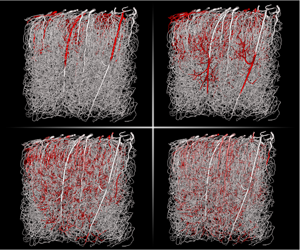Crossref Citations
This article has been cited by the following publications. This list is generated based on data provided by
Crossref.
Berg, M.
Coy, R.
Phillips, J.
and
Shipley, R.
2020.
Modelling regenerative angiogenesis in peripheral nerve injuries.
Computer Methods in Biomechanics and Biomedical Engineering,
Vol. 23,
Issue. sup1,
p.
S33.
Zimmerman, Robert A.
and
Tartakovsky, Daniel M.
2020.
Solute dispersion in bifurcating networks.
Journal of Fluid Mechanics,
Vol. 901,
Issue. ,
Goirand, Florian
Le Borgne, Tanguy
and
Lorthois, Sylvie
2021.
Network-driven anomalous transport is a fundamental component of brain microvascular dysfunction.
Nature Communications,
Vol. 12,
Issue. 1,
Kuchta, Miroslav
Laurino, Federica
Mardal, Kent-Andre
and
Zunino, Paolo
2021.
Analysis and Approximation of Mixed-Dimensional PDEs on 3D-1D Domains Coupled with Lagrange Multipliers.
SIAM Journal on Numerical Analysis,
Vol. 59,
Issue. 1,
p.
558.
Turuban, Régis
Lhuissier, Henri
and
Metzger, Bloen
2021.
Mixing in a sheared particulate suspension.
Journal of Fluid Mechanics,
Vol. 916,
Issue. ,
Puyguiraud, Alexandre
Gouze, Philippe
and
Dentz, Marco
2021.
Pore-Scale Mixing and the Evolution of Hydrodynamic Dispersion in Porous Media.
Physical Review Letters,
Vol. 126,
Issue. 16,
Berg, Maxime
Holroyd, Natalie
Walsh, Claire
West, Hannah
Walker-Samuel, Simon
and
Shipley, Rebecca
2022.
Challenges and opportunities of integrating imaging and mathematical modelling to interrogate biological processes.
The International Journal of Biochemistry & Cell Biology,
Vol. 146,
Issue. ,
p.
106195.
Picchi, D.
and
Poesio, P.
2022.
Dispersion of a passive scalar around a Taylor bubble.
Journal of Fluid Mechanics,
Vol. 951,
Issue. ,
Merlo, Adlan
Berg, Maxime
Duru, Paul
Risso, Frédéric
Davit, Yohan
and
Lorthois, Sylvie
2022.
A few upstream bifurcations drive the spatial distribution of red blood cells in model microfluidic networks.
Soft Matter,
Vol. 18,
Issue. 7,
p.
1463.
Budiša, Ana
Hu, Xiaozhe
Kuchta, Miroslav
Mardal, Kent-André
and
Zikatanov, Ludmil T.
2023.
HAZniCS – Software Components for Multiphysics Problems.
ACM Transactions on Mathematical Software,
Vol. 49,
Issue. 4,
p.
1.
Samavaki, Maryam
Oluwatoki Yusuf, Yusuf
Nia, Arash Zarrin
Söderholm, Santtu
Lahtinen, Joonas
Galaz Prieto, Fernando
and
Pursiainen, Sampsa
2023.
Pressure–Poisson equation in numerical simulation of cerebral arterial circulation and its effect on the electrical conductivity of the brain.
Computer Methods and Programs in Biomedicine,
Vol. 242,
Issue. ,
p.
107844.
Liu, Yang
Gong, Wenbo
Xiao, Han
and
Wang, Moran
2024.
A pore-scale numerical framework for solute transport and dispersion in porous media.
Advances in Water Resources,
Vol. 183,
Issue. ,
p.
104602.
Samavaki, Maryam
Söderholm, Santtu
Nia, Arash Zarrin
and
Pursiainen, Sampsa
2024.
Modeling of blood flow in cerebral arterial circulation and its dynamic impact on electrical conductivity in a realistic multi-compartment head model.
Computer Methods and Programs in Biomedicine,
Vol. 244,
Issue. ,
p.
107983.
Pastor-Alonso, David
Berg, Maxime
Boyer, Franck
Fomin-Thunemann, Natalie
Quintard, Michel
Davit, Yohan
Lorthois, Sylvie
and
Beard, Daniel A
2024.
Modeling oxygen transport in the brain: An efficient coarse-grid approach to capture perivascular gradients in the parenchyma.
PLOS Computational Biology,
Vol. 20,
Issue. 5,
p.
e1011973.
Walsh, Claire L.
Berg, Maxime
West, Hannah
Holroyd, Natalie A.
Walker-Samuel, Simon
and
Shipley, Rebecca J.
2024.
Reconstructing microvascular network skeletons from 3D images: What is the ground truth?.
Computers in Biology and Medicine,
Vol. 171,
Issue. ,
p.
108140.
Blanco, Pablo J.
and
Müller, Lucas O.
2025.
One‐Dimensional Blood Flow Modeling in the Cardiovascular System. From the Conventional Physiological Setting to Real‐Life Hemodynamics.
International Journal for Numerical Methods in Biomedical Engineering,
Vol. 41,
Issue. 3,
Samavaki, Maryam
Söderholm, Santtu
Zarrin Nia, Arash
and
Pursiainen, Sampsa
2025.
A coupled diffusion approximation for spatiotemporal hemodynamic response and deoxygenated blood volume fraction in microcirculation.
Biomedical Signal Processing and Control,
Vol. 101,
Issue. ,
p.
107183.
Fiori, Matilde
Pramanik, Satyajit
and
MacMinn, Christopher W.
2025.
Solute transport due to periodic loading in a soft porous material.
Journal of Fluid Mechanics,
Vol. 1009,
Issue. ,
Yousofvand, Reza
and
Tithof, Jeffrey
2025.
Numerical Simulations Reveal Complementary Function of Blood-Brain Barrier and Glymphatic Transport in the Brain.
Physical Review Letters,
Vol. 134,
Issue. 13,
